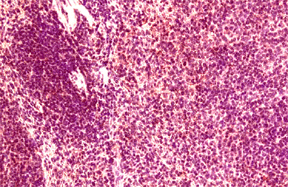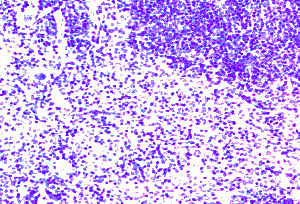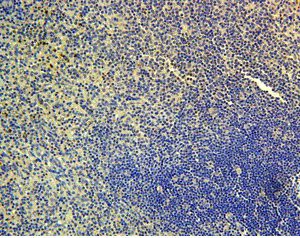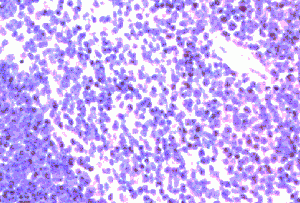
anti-mouse CCR4 N-Terminal
$345.00
Amount: 200 ug
Synonyms: C-C CKR-4, CC-CKR-4, and CCR-4
Specifications
Host Species: Goat
Antigen: Synthetic peptide DTTQDETVYNSYYFYESMP-C corresponds to amino acid residues 8 - 26 of mouse CCR4 with cysteine added for coupling to a carrier protein
Reactive Species: Mouse
Format/Conjugates/Purification: Peptide Affinity Purification
Buffer & Formulation: Affinity purified antibody in 10 mM KHPO4, 140 mM NaCl, BSA with 0.1 % sodium azide
Storage: Aliquot and freeze at -20° C. Avoid freeze-thaw cycles.
Clone: Polyclonal
Applications
ELISA: 1:25,000
Western Blotting: 1:500
IHC: 1:250
Flow Cytometry: 2ul/10^6 cells/100ul
References
Honjo A, Ogawa H, Azuma M, Tezuka T, Sone S, Biragyn A, Nishioka Y. Targeted reduction of CCR4(+) cells is sufficient to suppress allergic airway inflammation. Respir Investig. 2013 Dec;51(4):241-9. Abstract IH
Ferguson AR, Engelhard VH. CD8 T cells activated in distinct lymphoid organs differentially express adhesion proteins and coexpress multiple chemokine receptors. J Immunol. 2010 Apr 15;184(8):4079-86. Abstract FC
Raimondi G, Sumpter TL, Matta BM, Pillai M, Corbitt N, Vodovotz Y, Wang Z, Thomson AW Mammalian target of rapamycin inhibition and alloantigen-specific regulatory T cells synergize to promote long-term graft survival in immunocompetent recipients. J Immunol. 2010 Jan 15;184(2):624-36 Abstract FC Guo Z, Jang MH, Otani K, Bai Z, Umemoto E, Matsumoto M, Nishiyama M, Yamasaki M, Ueha S, Matsushima K, Hirata T, Miyasaka M. CD4+CD25+ regulatory T cells in the small intestinal lamina propria show an effector/memory phenotype. Int Immunol. 2008 Mar;20(3):307-15. Abstract FC
Kanagawa N, Niwa M, Hatanaka Y, Tani Y, Nakagawa S, Fujita T, Yamamoto A, Okada N. CC-chemokine ligand 17 gene therapy induces tumor regression through augmentation of tumor-infiltrating immune cells in a murine model of preexisting CT26 colon carcinoma. Int J Cancer. 2007 Nov 1;121(9):2013-22. Abstract FC
Khader SA, Bell GK, Pearl JE, Fountain JJ, Rangel-Moreno J, Cilley GE, Shen F, Eaton SM, Gaffen SL, Swain SL, Locksley RM, Haynes L, Randall TD, Cooper AM. IL-23 and IL-17 in the establishment of protective pulmonary CD4+ T cell responses after vaccination and during Mycobacterium tuberculosis challenge. Nat Immunol. 2007 Apr;8(4):369-77. Abstract FC
Tsunemi Y, Saeki H, Nakamura K, Nagakubo D, Nakayama T, Yoshie O, Kagami S, Shimazu K, Kadono T, Sugaya M, Komine M, Matsushima K, Tamaki K. CCL17 transgenic mice show an enhanced Th2-type response to both allergic and non-allergic stimuli. Eur J Immunol. 2006 Aug;36(8):2116-27. Abstract IH
Ochando JC, Homma C, Yang Y, Hidalgo A, Garin A, Tacke F, Angeli V, Li Y, Boros P, Ding Y, Jessberger R, Trinchieri G, Lira SA, Randolph GJ, Bromberg JS. Alloantigen-presenting plasmacytoid dendritic cells mediate tolerance to vascularized grafts. Nat Immunol. 2006 Jun;7(6):652-62. Abstract FC
Morimoto Y, Bian Y, Gao P, Yashiro-Ohtani Y, Zhou XY, Ono S, Nakahara H, Kogo M, Hamaoka T, Fujiwara H. Induction of surface CCR4 and its functionality in mouse Th2 cells is regulated differently during Th2 development. J Leukoc Biol. 2005 Sep;78(3):753-61. Full Text FC
Jakubzick C, Wen H, Matsukawa A, Keller M, Kunkel SL, Hogaboam CM. Role of CCR4 ligands, CCL17 and CCL22, during Schistosoma mansoni egg-induced pulmonary granuloma formation in mice. Am J Pathol. 2004 Oct;165(4):1211-21 Full Text IH





Comments
Peptide sequence is < 50 % identical to other human chemokine receptors in this region. The antibody recognizes mouse CCR4 and has no cross-reactivity to human CCR4.